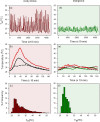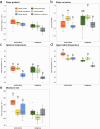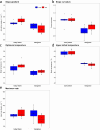Conservation of thermal physiology in tropical intertidal snails following an evolutionary transition to a cooler ecosystem: climate change implications
- PMID: 37533818
- PMCID: PMC10393397
- DOI: 10.1093/conphys/coad056
Conservation of thermal physiology in tropical intertidal snails following an evolutionary transition to a cooler ecosystem: climate change implications
Abstract
Predictions for animal responses to climate warming usually assume that thermal physiology is adapted to present-day environments, and seldom consider the influence of evolutionary background. Little is known about the conservation of warm-adapted physiology following an evolutionary transition to a cooler environment. We used cardiac thermal performance curves (cTPCs) of six neritid gastropod species to study physiological thermal trait variation associated with a lineage transition from warmer rocky shores to cooler mangroves. We distinguished between functional thermal performance traits, related to energy homeostasis (slope gradient, slope curvature, HRmax, maximum cardiac activity and Topt, the temperature that maximizes cardiac activity) and a trait that limits performance (ULT, the upper lethal temperature). Considering the theory of optimal thermal performance, we predicted that the functional traits should be under greater selective pressure to change directionally and in magnitude than the thermal limit, which is redundant in the cooler environment. We found little variation in all traits across species, habitats and ecosystems, despite a ~20°C reduction in maximum habitat temperature in the mangrove species over 50 million years. While slope gradient was significantly lowered in the mangrove species, the effect difference was negated by greater thermal plasticity in the rocky shore species. ULT showed the least variation and suggested thermal specialization in the warmest habitat studied. The observed muted variation of the functional traits among the species may be explained by their limited role in energy acquisition and rather their association with heat tolerance adaptation, which is redundant in the mangrove species. These findings have implications for the conservation of habitat of intertidal gastropods that transition to cooler environments. Furthermore, they highlight the significance of evolutionary history and physiological conservation when predicting species responses to climate change.
Keywords: ecophysiology; gastropod; heat tolerance; thermal performance curve.
© The Author(s) 2023. Published by Oxford University Press and the Society for Experimental Biology.
Conflict of interest statement
The authors declare no competing interests.
Figures








Similar articles
-
Thermal tolerance and climate warming sensitivity in tropical snails.Ecol Evol. 2015 Dec 2;5(24):5905-19. doi: 10.1002/ece3.1785. eCollection 2015 Dec. Ecol Evol. 2015. PMID: 26811764 Free PMC article.
-
Gross mismatch between thermal tolerances and environmental temperatures in a tropical freshwater snail: climate warming and evolutionary implications.J Therm Biol. 2015 Jan;47:99-108. doi: 10.1016/j.jtherbio.2014.11.009. Epub 2014 Nov 25. J Therm Biol. 2015. PMID: 25526660
-
Why are 'suboptimal' temperatures preferred in a tropical intertidal ectotherm?J Anim Ecol. 2022 Jul;91(7):1400-1415. doi: 10.1111/1365-2656.13690. Epub 2022 Apr 14. J Anim Ecol. 2022. PMID: 35302242
-
Functional Traits of Terrestrial Plants in the Intertidal: A Review on Mangrove Trees.Biol Bull. 2021 Oct;241(2):123-139. doi: 10.1086/716510. Epub 2021 Oct 8. Biol Bull. 2021. PMID: 34706208 Review.
-
Physiological adaptation to cities as a proxy to forecast global-scale responses to climate change.J Exp Biol. 2021 Feb 24;224(Pt Suppl 1):jeb229336. doi: 10.1242/jeb.229336. J Exp Biol. 2021. PMID: 33627462 Review.
References
-
- Angilletta MJ (2009) Thermal Adaptation: A Theoretical and Empirical Synthesis. Oxford University Press, Oxford, England
-
- Barker C, Monaco CJ, McQuaid CD (2021) Exposure to fluctuating temperature increases thermal sensitivity in two lineages of the intertidal mussel Perna perna. Mar Ecol Prog Ser 668: 85–95. 10.3354/meps13713. - DOI
LinkOut - more resources
Full Text Sources

